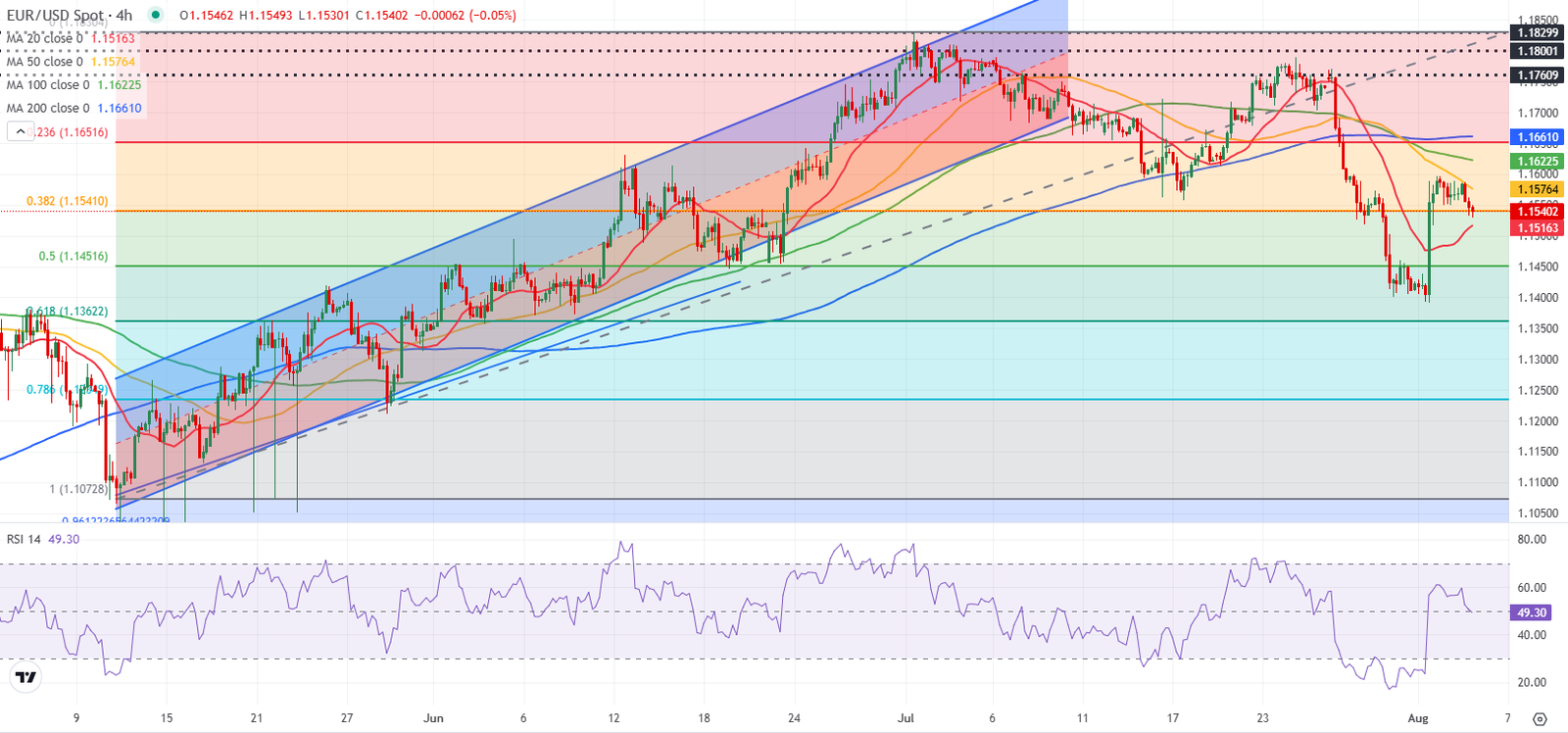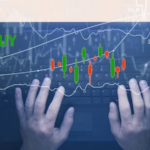- EUR/USD trades in negative territory below 1.1550 on Tuesday.
- Markets await July ISM Services PMI data from the US.
- The near-term technical outlook points to a lack of buyer interest.
EUR/USD stays under modest bearish pressure and fluctuates below 1.1550 in the European session on Tuesday after posting marginal losses on Monday. The near-term technical outlook suggest that buyers remain on the sidelines.
Euro PRICE This week
The table below shows the percentage change of Euro (EUR) against listed major currencies this week. Euro was the weakest against the US Dollar.
| USD | EUR | GBP | JPY | CAD | AUD | NZD | CHF | |
|---|---|---|---|---|---|---|---|---|
| USD | 0.42% | -0.05% | 0.16% | 0.14% | 0.29% | 0.27% | 0.61% | |
| EUR | -0.42% | -0.42% | -0.24% | -0.28% | -0.26% | -0.16% | 0.16% | |
| GBP | 0.05% | 0.42% | 0.20% | 0.15% | 0.17% | 0.26% | 0.59% | |
| JPY | -0.16% | 0.24% | -0.20% | -0.01% | -0.01% | 0.10% | 0.62% | |
| CAD | -0.14% | 0.28% | -0.15% | 0.00% | -0.01% | 0.13% | 0.45% | |
| AUD | -0.29% | 0.26% | -0.17% | 0.01% | 0.01% | 0.09% | 0.44% | |
| NZD | -0.27% | 0.16% | -0.26% | -0.10% | -0.13% | -0.09% | 0.32% | |
| CHF | -0.61% | -0.16% | -0.59% | -0.62% | -0.45% | -0.44% | -0.32% |
The heat map shows percentage changes of major currencies against each other. The base currency is picked from the left column, while the quote currency is picked from the top row. For example, if you pick the Euro from the left column and move along the horizontal line to the US Dollar, the percentage change displayed in the box will represent EUR (base)/USD (quote).
In the absence of high-impact data releases, the US Dollar (USD) staged a modest rebound on Monday and erased a small portion of the losses it suffered on the dismal employment data to end the previous week.
Early Tuesday, the USD holds its ground and doesn’t allow EUR/USD to keep its footing. In the second half of the day, the US economic calendar will feature Goods Trade Balance data for June and the Institute for Supply Management’s (ISM) Services Purchasing Managers Index (PMI).
The ISM Services PMI is expected to rise to 51.5 from 50.8 in June. A reading below 50, which would point to a contraction in the service sector’s economic activity, could cause the USD to weaken and help EUR/USD gain traction. Conversely, a better-than-forecast print could support the USD.
In case the headline PMI comes in near the market consensus, investors could react to the Employment Index of the survey, which stood at 47.2 in June. A decrease in this number could remind investors of the worsening labor market conditions and hurt the USD. On the other hand, the USD could stay resilient against its peers if this sub-index rises above 50 in July to show a growth in the service sector’s payrolls.
EUR/USD Technical Analysis

The Relative Strength Index (RSI) indicator on the 4-hour chart stays slightly below 50 in the European session, highlighting a lack of buyer interest.
On the downside, 1.1515-1.1500 (20-period Simple Moving Average (SMA), static level) aligns as the immediate support level before 1.1450 (Fibonacci 50% retracement of the latest uptrend) and 1.1400 (static level, round level).
Looking north, resistance levels could be spotted at 1.1570 (50-period SMA), 1.1620 (100-period SMA) and 1.1660 (Fibonacci 23.6% retracement, 200-period SMA).
Euro FAQs
The Euro is the currency for the 19 European Union countries that belong to the Eurozone. It is the second most heavily traded currency in the world behind the US Dollar. In 2022, it accounted for 31% of all foreign exchange transactions, with an average daily turnover of over $2.2 trillion a day.
EUR/USD is the most heavily traded currency pair in the world, accounting for an estimated 30% off all transactions, followed by EUR/JPY (4%), EUR/GBP (3%) and EUR/AUD (2%).
The European Central Bank (ECB) in Frankfurt, Germany, is the reserve bank for the Eurozone. The ECB sets interest rates and manages monetary policy.
The ECB’s primary mandate is to maintain price stability, which means either controlling inflation or stimulating growth. Its primary tool is the raising or lowering of interest rates. Relatively high interest rates – or the expectation of higher rates – will usually benefit the Euro and vice versa.
The ECB Governing Council makes monetary policy decisions at meetings held eight times a year. Decisions are made by heads of the Eurozone national banks and six permanent members, including the President of the ECB, Christine Lagarde.
Eurozone inflation data, measured by the Harmonized Index of Consumer Prices (HICP), is an important econometric for the Euro. If inflation rises more than expected, especially if above the ECB’s 2% target, it obliges the ECB to raise interest rates to bring it back under control.
Relatively high interest rates compared to its counterparts will usually benefit the Euro, as it makes the region more attractive as a place for global investors to park their money.
Data releases gauge the health of the economy and can impact on the Euro. Indicators such as GDP, Manufacturing and Services PMIs, employment, and consumer sentiment surveys can all influence the direction of the single currency.
A strong economy is good for the Euro. Not only does it attract more foreign investment but it may encourage the ECB to put up interest rates, which will directly strengthen the Euro. Otherwise, if economic data is weak, the Euro is likely to fall.
Economic data for the four largest economies in the euro area (Germany, France, Italy and Spain) are especially significant, as they account for 75% of the Eurozone’s economy.
Another significant data release for the Euro is the Trade Balance. This indicator measures the difference between what a country earns from its exports and what it spends on imports over a given period.
If a country produces highly sought after exports then its currency will gain in value purely from the extra demand created from foreign buyers seeking to purchase these goods. Therefore, a positive net Trade Balance strengthens a currency and vice versa for a negative balance.



















